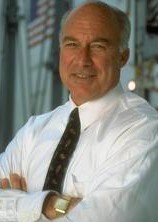-
(b.) - ?1938 October 18
Bio/Description
The 31-year IBM employee (1961 to 1992), he is also a former AT&T Chairman and CEO. He tried to reestablish AT&T as an end-to-end carrier, but unfortunately, due to the dot.com bust and various other issues, he was forced to break the group up in 2001. Born in in pre?World War II Detroit, Michigan, the eldest of three sons he was President of his high school senior class and earned college-football scholarships. His athletic and future U.S. Marine Corps careers ended due to a gridiron shoulder injury. Surgery on the shoulder resulted in his right arm being shorter than his left. In place of football he made time to be the President of his fraternity, Sigma Nu, and worked for the all fraternity council, the college publications board, as well as the honorary business society. In the April 22, 1996, issue of BusinessWeek he recalled how his mother's motto, "no limits" inspired the family while his father struggled to start a business after being laid-off. He worked odd jobs to pay for tuition, successfully attaining his B.S. degree in Business from Miami University of Ohio in 1961. In that same year he joined IBM Corporation in Indianapolis as a Systems Engineer. Once inside the rapidly growing computer company he soon moved over to sales and marketing, attending sales training programs with the future IBM CEO John Akers. Following Akers up the IBM corporate ladder, he attended a Dartmouth Institute for Advanced-Management Education, which he finished in 1976. In 1978 he was named President of a high-level IBM division, Data Processing, and in 1980 became Corporate Vice President. In 1983 he was named a Senior Vice President and group executive in the Communications division, where he was responsible for the development and manufacture of minicomputers, personal computers and software, and communications-network technology?the last of which included an early joint attempt at global communications networking, dubbed Satellite Business Systems, with the future competitor MCI Corporation. He surprised the business world in February 1992 when he announced that he would leave IBM after 31 years in order to become the CEO and Chairman of Hughes Aircraft Company; the defense unit of General Motors Corporation's Hughes Electronics group. At Hughes, he expedited development of DirecTV to establish one of the first digital-broadcast systems. He was the first Hughes CEO to come from outside not only the billionaire Howard Hughes's former research facility but the entire defense industry. The announcement of his appointment, which followed an earlier reorganization wherein focus was shifted to nondefense markets after the collapse of the Soviet Union, was a clear message that Hughes would be targeting commercial markets, including communication and satellite systems. In 1997 he joined AT&T Corporation, serving as Chairman and CEO. In a bold, historic move to reestablish itself as an end-to-end carrier during the dot-com boom, under his watch AT&T acquired two of the four largest U.S. cable-television companies for $102 billion in 1998. With the dot-com collapse, fraud-assisted telecom depression, unyielding regulatory battles, high debt load, and the sheer complexity and size of the acquisitions, he was forced to break AT&T up in 2001. He resigned from AT&T in 2002 and was succeeded by AT&T President David Dorman. From 2002-2003 he served as Chairman of Comcast Corporation, retiring in 2004 as nonexecutive Chairman of the Board. He also served as a Director of Citigroup from 1989 to 2010. He is a member of the Alfalfa Club and the Council on Foreign Relations. In addition, he received honorary Degrees from Pepperdine University in 1997; Loyola Marymount University in 1998 and Worcester Polytechnic Institute in 2000.
-
Date of Birth:
1938 October 18 -
Noted For:
Responsible for the development and manufacture of minicomputers, personal computers and software at IBM -
Category of Achievement:
-
More Info:


